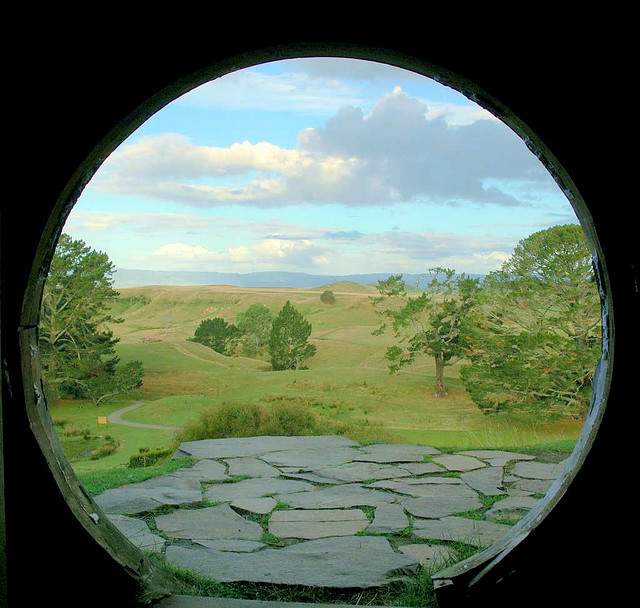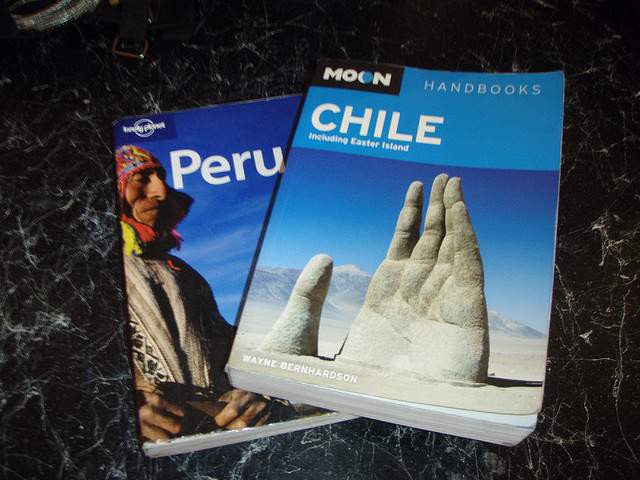It is true that guidebooks are loaded with useful information. But travelers reading sample itineraries are quickly tricked into thinking that their guidebook can save them from missing something spectacular. Soon they’re pulling it out at every opportunity and burying their noses in it as they walk through crowds. Meanwhile, they fail to notice that at that very moment they might be missing genuine, unique, spontaneous experiences. If someone could only shake them out of this trance to say:
“This is the trip! This is it! Over here are fresh lychees for sale! Look! There are children playing soccer in circles at your feet!”
How guidebooks are similar to Lord of the Rings
We travelers are blessed with endless sources of literary inspiration for our myriad wanderings. Certain characters jump off the page and seem to almost lead us along by hand—pausing now and again to whisper sage advice in our ears. There’s much to be gleaned from Dean and Sal in On the Road, Richard in The Beach, Huck and Jim in The Adventures of Huckleberry Finn—but perhaps no character from literature provides such a perfect metaphor for the post-modern traveler as Frodo Baggins in the Lord of the Rings.
Through his journey, Frodo carries a golden ring which, though invaluable at times, threatens to become his undoing. It calls out to be worn, tempting the hobbit at every turn. Here in our world, travelers often pack a comparable burden, one that’s similarly glossy and seemingly just as useful but soon casts a spell over its owner. It is the guidebook.
Believe it or not, this idea isn’t the major leap that it first appears to be. Both Frodo’s ring and the traveler’s handy guidebook are entrancing—bestowing upon their owners a false sense of control and security. Both have alluring qualities and can be useful in certain situations but are crippling when relied upon too heavily.
Once a guidebook has someone in its grip, it seldom lets go until the exit visas are stamped. When the fog finally lifts, many travelers are left with the sinking sensation of having shadowed someone else’s path.
As you may have guessed, I am generally anti-guidebook and have made sparing use of them. But recently, on my way to Ecuador, I felt compelled to pick up a guidebook a few weeks before departure. My reason was simple and consistent with the rationale of many a guidebook user: the trip was too short to go in completely blind.
Like Frodo, keeping the power of the ring at bay by passing it off to his friend Sam, I devised a plan to ensure that the guidebook’s presence wouldn’t overpower my experience.
The five points that follow outline my strategy for those who may want to give it a try:
1 – Don’t bring it
This is the most crucial step; you must leave the guidebook at home. That doesn’t mean you’re not using it at all, you certainly are: as a research tool before departure. Read it, study up, look at routes, gather information—then set it back on the shelf. Why bother with a paperback facsimile of a country when you are right there in the thick of things?
Read it, study up, look at routes, gather information—then set it back on the shelf. Why bother with a paperback facsimile of a country when you are right there in the thick of things?
It’s a little like the SCUBA diver who brings his fish chart with him underwater. Sure, study up on land, compare notes, discuss the fish you saw and see if you can figure out what each one was—but why waste precious oxygen while you’re underwater looking away from the ACTUAL fish to a pasteboard drawing of them? You’re better off focusing on the experience at hand.
Read more about 10 Non-Travel Resources To Help You Travel Better
2 – Make notes
Instead of bringing your guidebook along, jot down a few thoughts in a small notebook. Write down the names of interesting sounding sights, a waterfall, a town. If you feel you must, take notes on hotels or guesthouses that seem particularly interesting—but put a question mark next to the names and check them out in person.
Even the best guidebooks contain tons of material that you only need to see once. Read it at home, after that it’s dead weight.
The point is not to practice your transcription skills; the point is that you’ll be much more approachable glancing at a handheld notebook than a 300-page doorstop with a highly recognizable cover (which all the guidebooks have…if I could walk through Red Square with a guidebook that looked like War and Peace then maybe). Even the best guidebooks contain tons of material that you only need to see once. Read it at home, after that it’s dead weight.
3 – Read the ‘Dangers’ chapter
These are usually the most valuable pages of any guidebook. Read about when and where the muggings happen (guidebooks generally get this right), what illnesses are prevalent, and where it’s unsafe to swim.
Read the list of common scams as if it were a pulp crime novel.
This, if anything, is where a guidebook’s favorable attributes are reminiscent of Frodo’s ring—helping to make its owner invisible to potential threats to their safety.
I’m constantly amazed at the common scams that traveler’s fall for. For instance, the “Grand Palace is closed today” scam in Bangkok.
I’m constantly amazed at the common scams that traveler’s fall for. For instance, the “Grand Palace is closed today” scam in Bangkok. It goes like this: Tourist gets in a tuk-tuk to go to the Grand Palace, one of Bangkok’s top sites. The driver tells the traveler(s) the Grand Palace is closed today, but he will take you on a very special tour of other famous temples in the city. While he may do that, he’ll also bring you to many gem and carpet shops (the driver will get some kind of kickback from shop owners for bringing tourists into the shop). Meanwhile, thousands of travelers are at the very open Grand Palace while you’re wiling away inside some shop getting the hard sell on some crappy jewelry.
If only these travelers would have spent more time reading the guidebook section about common scams instead of the best party hostel on Khao San Road.
Read more about 10 of the Most Dangerous Destinations
4 – Don’t trust them
Not all the way at least. Keep in mind that guidebooks have authors. Those authors are reflecting their own personal impressions, which, while certainly of interest, may not reflect your impressions. The guidebook becomes a liability when the opinions of the writer (who gets tired, hungry and cranky at times, just like the rest of us) are overvalued.
There’s a lot of lag time between when a book is researched and when it hits bookstores, where as talking to locals offers up to the minute information.
Remember, there are lots of ways to gather information—local recommendations and advice are particularly crucial (yet underused) assets to any traveler. There’s a lot of lag time between when a book is researched and when it hits bookstores, where as talking to locals offers up to the minute information.
Chat, ask questions, get strangers to share their favorite cheap restaurant, food kiosk or four-star dining experience. Scribble names in your notebook. Collect as many opinions as you can. When the same places start coming up over and over, you’ve found a good launching off point.
5 – Accept the fact that you are going to miss something
The guidebook gives us the illusion that we can see, taste, touch and try everything all on one trip. But most trips aren’t long enough (no matter how long your trip is) to make that a real possibility—in fact, most lives aren’t long enough to make that a real possibility. Trying to do it all often leaves people feeling as if they’re running a race they can’t win: constantly wanting to see more, but inevitably experiencing less.
At a breakneck pace you don’t have the luxury of meeting people, getting lost in winding cobblestones streets (and who could with their guidebook map in hand?), or sharing in the hospitality of strangers—all of the things that people want to do when they travel.
Trying to do it all often leaves people feeling as if they’re running a race they can’t win: constantly wanting to see more, but inevitably experiencing less.
My advice: slow down, pick a smaller amount of space to cover, focus on a region rather than a country. Slowing down helps to stretch your time out and leaves you open to the spur-of-the-moment—like joining the soccer game with those kids—and that’s where real, lasting travel memories come from.
This method may seem like extra work, but remember that like Frodo’s ring, the guidebook’s sway is seductive, and its overuse could derail any journey. In the spirit of the brave hobbit, the intrepid traveler is challenged to overcome this hypnotic power—by following the steps above, devising their own plan or (if all else fails) by giving the book a quick glance, making a few notes, and throwing it into the fires of Mordor.
Tead more about why Travel is Not a Contest
Read more:
- 8 Alternative Trip Planning Resources
- 7 Tips to Break the Mold
- 18 Travel Resolutions to Keep This Year
Photo credits: Middle Earth, New Zealand, by sektordua on Flickr, Guidebooks by SheepsRUs on Flickr , Notes by laihiu on Flickr, Danger sign by Timewinder on Flickr , Sbarro’s by /me on Flickr, Red Square by McBadger on Flickr





